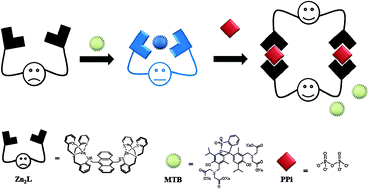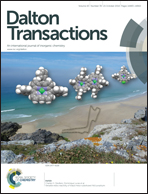Discriminate sensing of pyrophosphate using a new tripodal tetramine-based dinuclear Zn(ii) complex under an indicator displacement assay approach†
Abstract
In this research, the dinuclear Zn(II) complex of anthracene based tripodal tetramine Zn2L was synthesized, and its sensing abilities towards anions was investigated using the indicator displacement assay (IDA) approach with four complexometric indicators: pyrocatechol violet (PV), bromopyrogallol red (BPG), methylthymol blue (MTB) and xylenol orange (XO). UV-vis spectrophotometry results indicated that the Zn2L–MTB ensemble sensor could discriminate the pyrophosphate anion (PPi) from other phosphate containing anions. 1H and 31P NMR spectroscopy as well as DFT calculations confirmed that PPi bound to Zn2L in a 2 : 2 manner. Both NMR spectroscopy and UV-vis spectrophotometry suggested that the two bulky tripodal tetramine units in Zn2L played an important role to provide the ensemble cleft for MTB, giving rise to an ensemble that could be displaced exclusively by PPi. The detection limit of PPi for the reported IDA system was 0.3 μM in 20% (v/v) water–acetonitrile buffered at pH 7.4 with HEPES.


 Please wait while we load your content...
Please wait while we load your content...